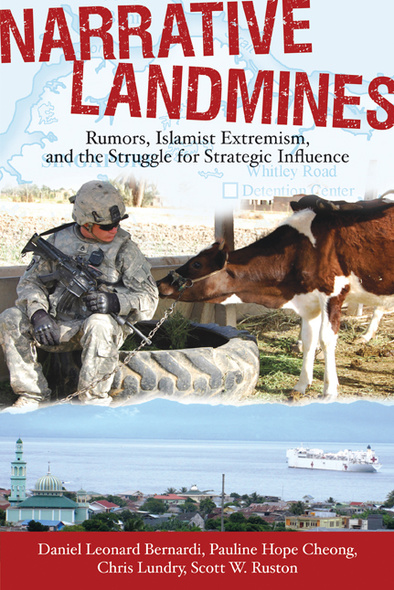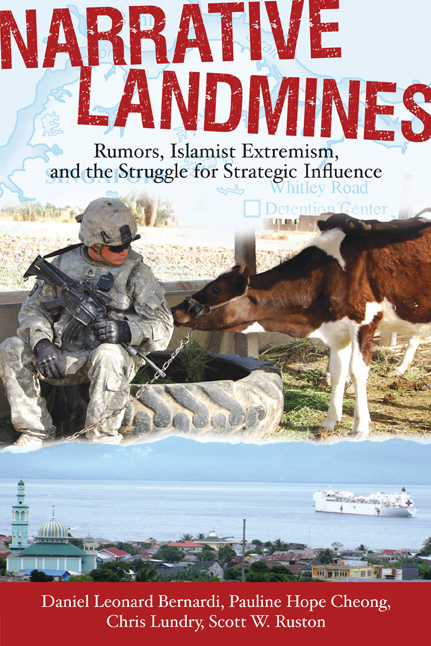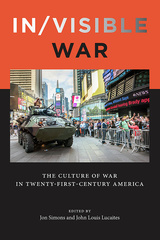
Narrative Landmines
Rumors, Islamist Extremism, and the Struggle for Strategic Influence
Islamic extremism is the dominant security concern of many contemporary governments, spanning the industrialized West to the developing world. Narrative Landmines explores how rumors fit into and extend narrative systems and ideologies, particularly in the context of terrorism, counter-terrorism, and extremist insurgencies. Its concern is to foster a more sophisticated understanding of how oral and digital cultures work alongside economic, diplomatic, and cultural factors that influence the struggles between states and non-state actors in the proverbial battle of hearts and minds. Beyond face-to-face communication, the authors also address the role of new and social media in the creation and spread of rumors.
As narrative forms, rumors are suitable to a wide range of political expression, from citizens, insurgents, and governments alike, and in places as distinct as Singapore, Iraq, and Indonesia—the case studies presented for analysis. The authors make a compelling argument for understanding rumors in these contexts as “narrative IEDs,” low-cost, low-tech weapons that can successfully counter such elaborate and expansive government initiatives as outreach campaigns or strategic communication efforts. While not exactly the same as the advanced technological systems or Improvised Explosive Devices to which they are metaphorically related, narrative IEDs nevertheless operate as weapons that can aid the extremist cause.
A strong and useful contribution to the field, Narrative Landmines makes important points about the relevance of rumor to counterinsurgency theory and operations.
Narrative Landmines is a goldmine of insights. It shows how pervasive and persistent rumors profoundly shape the strategically critical social realities and perceptions of vast cultures vulnerable to Islamic extremism.
Narrative Landmines shows the importance of understanding the role of rumors in strategic communication. Recommended.
DANIEL LEONARD BERNARDI is professor and chair of the Cinema Department at San Francisco State University. He is the author of Star Trek and History: Race-ing Toward a White Future and the editor of Filming Difference: Actors, Directors, Producers and Writers on Gender, Race and Sexuality in Film, among several other books. His research explores the representation and narration of cultural difference, including race, gender, and sexuality, in media and popular culture.
PAULINE HOPE CHEONG is an associate professor of communication at the Hugh Downs School of Human Communication at Arizona State University. She has published widely on communication technologies, culture, and religion in leading journals and is lead coeditor of Digital Religion, Social Media and Culture: Perspectives, Practices, Futures as well as New Media and Intercultural Communication: Identity, Community and Politics.
CHRIS LUNDRY is an assistant research professor at the Consortium for Strategic Communication in the Hugh Downs School of Human Communication at Arizona State University. He has published in edited volumes and journals, including American Behavioral Scientist and Inside Indonesia.
SCOTT W. RUSTON is an assistant research professor at the Hugh Downs School of Human Communication where he specializes in narrative theory and media studies. He has published in such journals as Storyworlds: A Journal of Narrative Studies and The International Journal of Technology and Human Interaction.
Introduction
1. Rumor Theory: Narrative Systems and Hegemonic Struggles in Contested Populations
2. Rumor Transmediation: Critical Mash-ups and a Singaporean Prison Break
3. Rumor Mosaics: Counterinsurgency Operations in Iraq’s Triangle of Death
4. Whisper Campaigns: State-Sponsored Rumors and the Post-Mortem (De)Construction of an Indonesian Terrorist
5. Coercion and Consent: Narrative Countermeasures in the Battle for “Hearts and Minds”
Glossary
Notes
Selected Bibliography
Index





